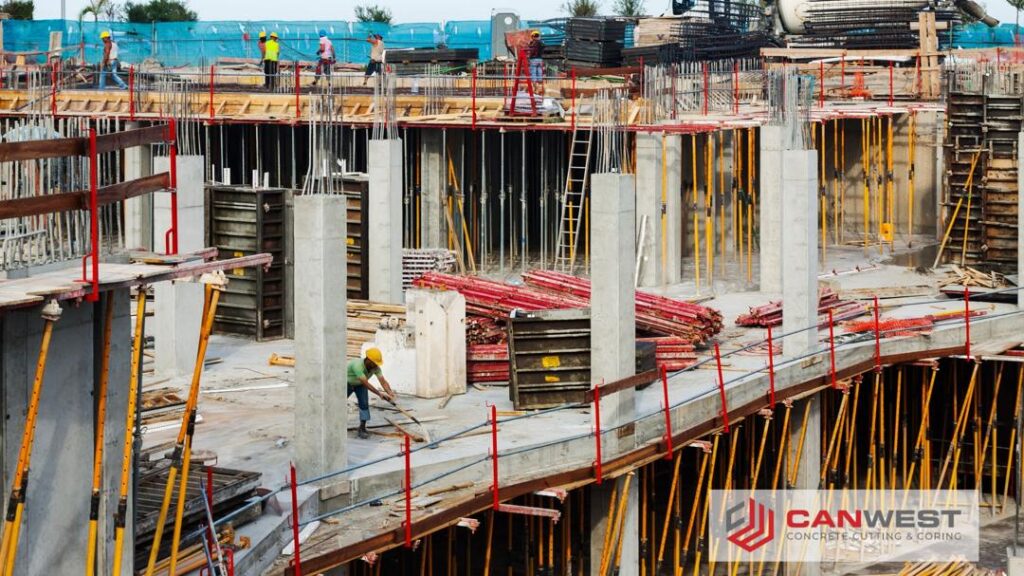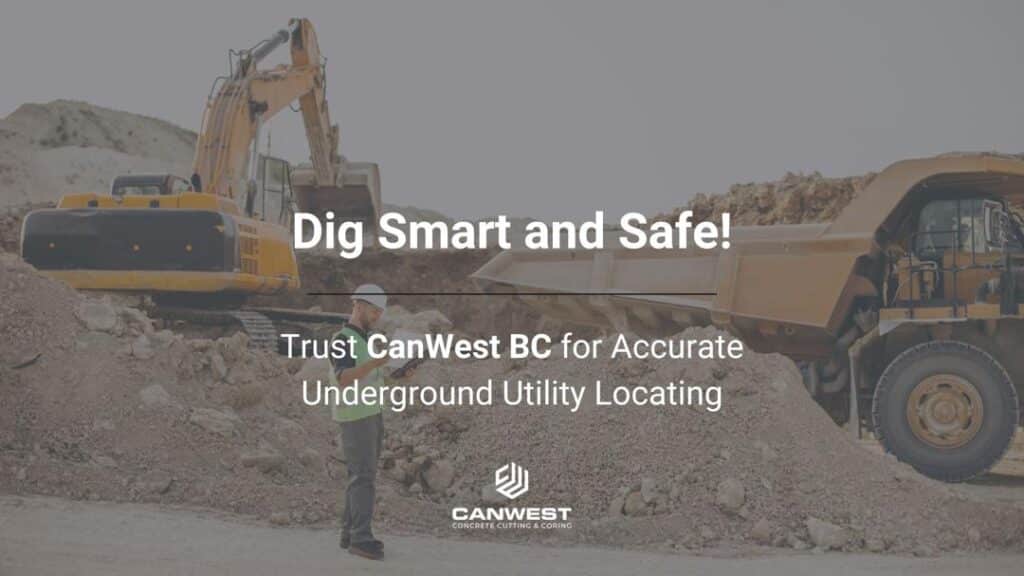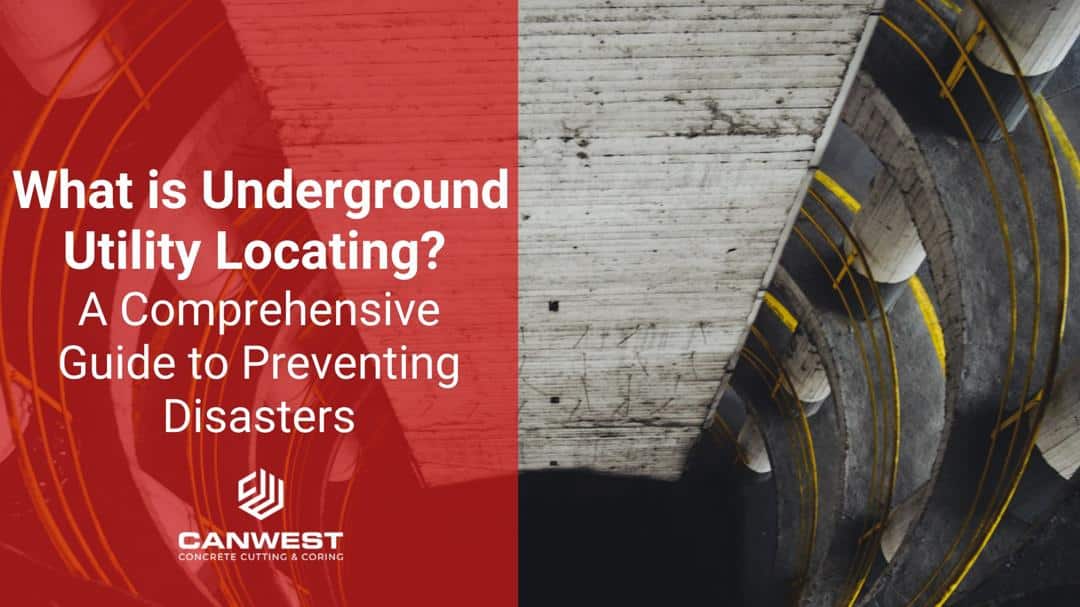At CanWest Concrete Cutting & Coring, we’ve learned one thing from years of working on high-stakes construction projects: the ground beneath your feet holds more than just soil. It carries a hidden web of critical infrastructure, such as gas lines, water pipes, electrical conduits, and communication cables, that can turn any job site into a risk zone if overlooked.
That’s where underground utility locating comes in. It's not just a precaution, it’s an essential strategy that protects your team, your timeline, and your bottom line. Whether you’re managing a multi-story commercial project or a municipal build, knowing what lies beneath isn’t optional, it’s vital.
In this guide, we will walk you through the importance of utility locating, common disasters caused by poor planning, the process we follow to ensure safety and precision, and everything you need to know about regulations, timelines, and what to do if something goes wrong. Because when it comes to construction, knowledge isn’t just power, it's protection.
Why is Underground Utility Locating Important?
When you're working on large-scale construction projects, especially those involving embedded systems, underground utility locating isn’t just advisable; it’s essential. Utilities such as gas lines, water pipes, sewer systems, electrical conduits, and telecommunications cables run beneath the surface in complex networks. Striking one of these lines can have devastating consequences in terms of safety, cost, and project timelines.
Utility locating services help prevent these scenarios by identifying the precise location of underground infrastructure before any digging or drilling begins. At CanWest Concrete Cutting & Coring, we utilize advanced underground utility locator equipment, including Ground Penetrating Radar (GPR) and electromagnetic locators, to ensure nothing is left to chance.
In addition, understanding the infrastructure below the surface is key when planning for future modifications or expansions. A complete record of underground utilities assists not only in construction safety but in the long-term management of facilities. Commercial property owners and municipal planners rely on this data to ensure future developments do not interfere with critical service lines.
Agencies such as Natural Resources Canada, through partnerships with the Canadian Common Ground Alliance, can support damage prevention initiatives and promote the use of advanced technologies for safe infrastructure development. This can reinforce the importance of thorough utility locating practices.
Common Disasters Caused by Poor Utility Locating
When underground utilities are not properly located, the risks are high and the consequences are immediate. Here are some of the most common and costly disasters:
- Gas Line Ruptures: One of the most dangerous incidents. A ruptured gas line can cause fires or explosions, endangering workers and nearby properties.
- Water Main Breaks: Flooding and structural damage can result, delaying projects and adding unexpected costs.
- Power Outages: Striking electrical lines can shut down entire job sites and even disrupt services for surrounding neighbourhoods.
- Telecommunications Disruptions: Severing fiber optic or telecom lines can result in business outages, impacting thousands of people.
These situations are not just expensive,they’re preventable. That’s why our utility locating services are a foundational element of every project we undertake.
The Process of Underground Utility Locating
So, how does utility locating work? The process is more technical and structured than most people realize. Here’s a step-by-step breakdown.
1. Site Analysis and Planning
Every job begins with a thorough site assessment. We evaluate historical utility maps, assess ground conditions, and identify high-risk zones.
2. Selection of Locating Method
We choose the appropriate methods of utility locating, such as:
- Ground Penetrating Radar (GPR): Effective for detecting non-metallic objects like PVC pipes.
- Electromagnetic Locating (EM): Ideal for metallic pipes and cables.
As noted in a critical review published in Automation in Construction, effective underground utility mapping requires a combination of technologies, data integration methods, and advanced scanning techniques to improve accuracy and prevent damage
3. Marking and Documentation
Located utilities are marked on-site using color-coded flags and paint. Detailed documentation is prepared for client reference and future use. Site mapping is also done to keep a clear record of what lies beneath the surface.
4. Verification and Quality Assurance
Multiple scans and cross-checks are performed to verify results. At CanWest Concrete Cutting & Coring our team of utility locating specialists ensures each site is analyzed thoroughly, using a combination of advanced scanning technologies and industry best practices to deliver pinpoint accuracy.

Utility Locating Services: How and Where to Access Them
Understanding how to access utility locating services is vital. In Canada, contractors and property owners must contact regional services such as Dig Alert or Ontario One Call before breaking ground. These services coordinate with utility providers to mark the location of public utilities.
In British Columbia, BC 1 Call provides similar services, helping contractors and property owners prevent unnecessary strikes and comply with provincial regulations.
However, not all utilities are public. Private utilities, which often include lines installed by property owners or those serving specific buildings, require private utility locators. CanWest Concrete Cutting & Coring partners with licensed utility locator professionals to identify both public and private networks. We use concrete scanning and utility scanning services that go beyond standard public database checks, ensuring all systems are accounted for before a project begins.
Utility maps are often available through city records or commercial surveying companies. We also assist in coordinating boundary surveys to help define the limits of excavation safely, especially in commercial projects and municipal projects where multiple utility lines may be present.
Target line direction and site-specific conditions must be evaluated to ensure accurate location services. At CanWest Concrete Cutting & Coring, we use a combination of utility maps, scanning equipment, and site analysis to ensure we meet all project requirements.
The Growing Need for Utility Locating in Urban Development
With cities becoming denser and more complex, the demand for accurate underground utility locating has never been higher. Commercial spaces and infrastructure developments are constantly expanding, often in areas with decades-old utility systems.
In such environments, experienced project managers play a vital role in coordinating locating services, ensuring that outdated maps and legacy infrastructure don’t hinder project timelines. This is where advanced scanning methods and professional utility locating services are indispensable.
Moreover, renovations and expansions in older buildings frequently involve interfacing with outdated utility systems. Knowing where utilities lie helps contractors avoid delays and ensures that upgrades are seamlessly integrated into existing infrastructure. From new condo developments to transportation hubs, underground utility locating forms the backbone of pre-construction risk mitigation.
Regulations and Laws Around Utility Locating
In Canada, strict regulations govern underground utility locating. Contractors are legally required to request a utility location before any excavation begins. Failure to comply can lead to hefty fines, legal liabilities, and project shutdowns.
Organizations like BC 1 Call and Ontario One Call act as intermediaries between contractors and utility providers. They provide essential dig alert services that help identify public infrastructure. We always initiate locates through the proper channels and adhere to all provincial and federal regulations.
For commercial projects, municipal builds, or any work involving excavation, compliance is not optional. From filing the locate request to documenting the site mapping results, every step must follow proper legal protocols.
Utility Locating Safety: A Non-Negotiable Priority
Utility locating safety is not just about avoiding disruptions, it’s about protecting lives. Every year, avoidable utility strikes result in serious injuries. Our commitment to safety means:
- Regularly calibrating our underground utility locator equipment
- Training our teams on best practices
- Conducting site-specific hazard assessments
Licensed utility locator professionals undergo extensive training to recognize signs of danger, understand underground pipe locator tools, and interpret utility scans effectively. Safety protocols are integrated into every stage of the locating process.
CanWest Concrete Cutting & Coring follows safety guidelines outlined by the Canadian Common Ground Alliance (CCGA), which detail industry best practices to ensure safe excavation and utility detection across Canada.
Utility Locating Costs and Timeframes
Clients often ask about utility locating costs and how it impacts the project schedule. Here’s what to expect:
- Cost: Costs vary based on site complexity, size, and the number of utilities involved. However, it’s a fraction of what you’d pay in damages if a line is struck. For most commercial spaces, the investment is minimal compared to potential risks.
- Timeframe: Basic locations can be completed within a few hours. Complex sites with deep or congested utilities may take longer. Public database checks are typically quick, but private utility locators might require additional site mapping and analysis.
On average, utility locating services can take anywhere from 24 hours to a few days depending on the type of networks involved. We help clients plan their schedules accordingly, ensuring no delays due to locating oversight. Main networks and private systems require different approaches, and both must be accounted for in the project timeline.
What to Do if You Hit an Underground Utility
Despite best efforts, utility strikes can still happen. Here’s what to do immediately:
Stop All Work Immediately
Shut down machinery, and clear the area.
Alert Authorities
Notify emergency services by calling 911 if there’s any risk of explosion or injury, especially if you smell natural gas.
Contact the Utility Provider
They’ll dispatch a crew to assess and repair the damage.
File an Incident Report
Document everything thoroughly for insurance and regulatory purposes.
Review and Adjust Protocols
Analyze what went wrong and implement corrective measures to prevent recurrence.
Our teams are trained to act quickly in such situations, ensuring damage control and safety come first.
Our Role in Complex, High-Stakes Projects
In many of these high-risk jobs, our work often begins with concrete demolition to expose existing systems before scanning, coring, or cutting can begin, allowing for a safe and accurate construction process. We have worked on everything from major commercial builds to subway repair work, where accuracy and safety are paramount.
Radar technology plays a crucial role in these scenarios. We use it not only to locate existing infrastructure but also to validate newly embedded systems before the concrete pour. Misaligned pipes or missing conduits are caught early, saving time, money, and reputations.

Specialized Services: Grinding and Polishing for Industrial Spaces
In addition to our utility locating and coring services, CanWest Concrete Cutting & Coring now offers specialized concrete grinding and polishing, particularly suited for industrial buildings in Vancouver.
Efficiency
Our cold concrete floor preparation method is 50 percent faster than traditional methods.
Epoxy Coating
We apply high-performance epoxy infused with rubber particles for durability and slip resistance—ideal for garage floors and warehouses.
Precision Process
Grinding must be done before epoxy application to ensure a smooth, long-lasting finish.
This service complements our utility locating expertise—helping clients achieve seamless, safe, and functional spaces from the ground up.
Precision is the Standard, Not the Goal
At CanWest Concrete Cutting & Coring, we don’t aim for precision, we expect it. Every utility location, every scan, and every polish is done with the same unwavering attention to detail. Because in our line of work, getting it wrong is not an option.
Whether you’re planning a small commercial build or overseeing a massive infrastructure project, underground utility locating is your first line of defense against catastrophe. And with CanWest Concrete Cutting & Coring by your side, you can trust that no line, pipe, or cable will go unnoticed.
Need expert utility locating services in Vancouver and beyond? Contact us today and let’s build safely together.

